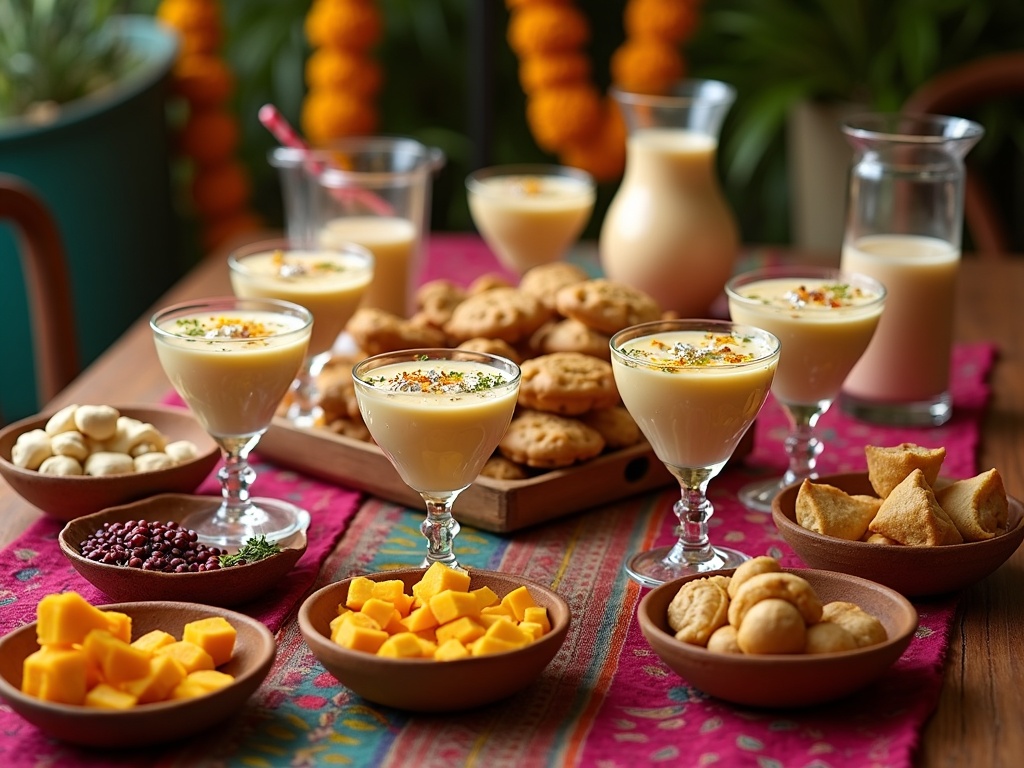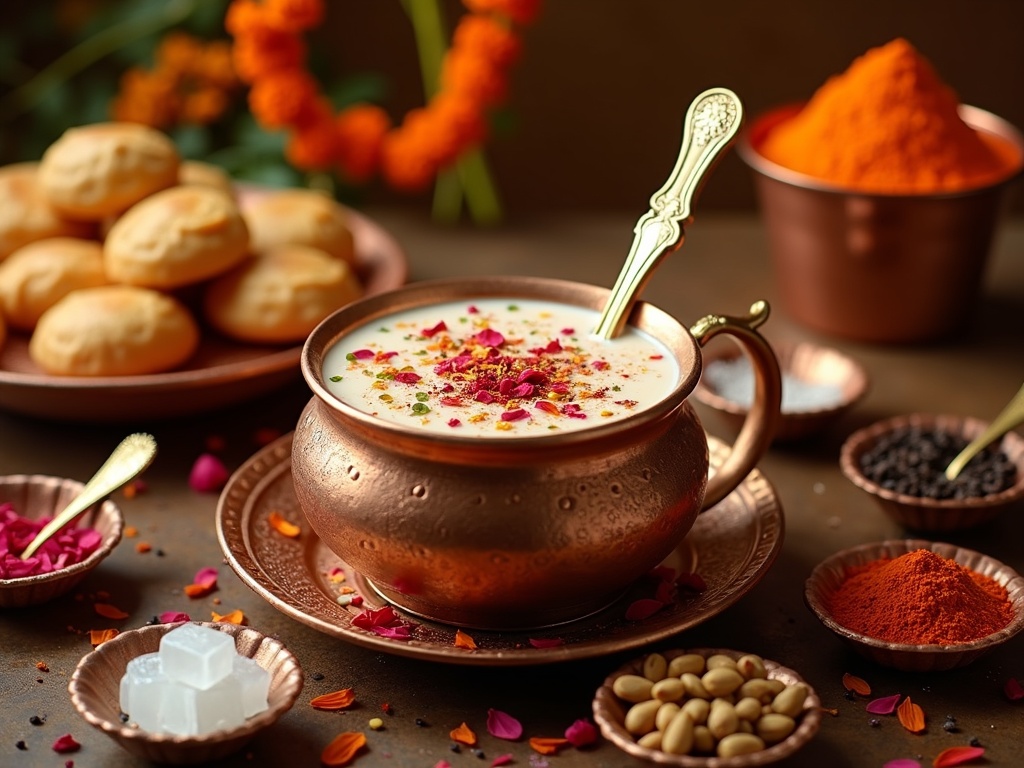Thandai: A Traditional Indian Spiced Milk Beverage
Thandai, a traditional Indian spiced milk beverage, blends cooling herbs, nuts, and aromatic spices into a refreshing drink that’s central to cultural celebrations like Holi and Mahashivratri.
Find In This Article
Key Takeaways
- The authentic thandai recipe requires full-fat milk as a base, combined with a paste of soaked nuts (almonds, pistachios) and specific spices including cardamom, black peppercorns, fennel seeds, and saffron.
- Proper preparation involves soaking nuts and seeds overnight, grinding them into a fine paste, and gradually incorporating this mixture into warm milk before chilling thoroughly.
- Thandai holds cultural importance during festivals like Holi and Mahashivratri, serving as both a refreshing beverage and a sacred offering in religious ceremonies.
- The beverage offers various health benefits, including cooling properties, digestive support, and nutritional value from its rich blend of nuts, spices, and milk.
- For the best serving experience, thandai should be thoroughly chilled and garnished with elements like slivered nuts, rose petals, or saffron strands, and paired with complementary sweet or savory foods.
Essential Ingredients for Your Thandai
Creating authentic thandai requires specific ingredients that blend together to form its distinctive taste profile. I’ve found that starting with the right components makes all the difference in achieving that perfect traditional flavor.
Core Components for Perfect Thandai
Full fat milk forms the creamy base of thandai. The richness of whole milk provides the smooth texture that’s essential to this satisfying drink, while also helping to carry the complex flavors of the spices and nuts. I don’t recommend substituting with low-fat alternatives as they simply don’t deliver the same luxurious mouthfeel.
The nut blend is crucial for authentic thandai. Almonds and pistachios need to be soaked overnight and ground into a fine paste. These nuts not only thicken the drink but also add a subtle earthy flavor that complements the spices. I sometimes toast them lightly before soaking to enhance their natural oils.
The signature flavor profile of thandai comes from its unique spice combination:
- Green cardamom pods provide a sweet, floral aroma that’s immediately recognizable
- Black peppercorns add a gentle heat that warms the throat
- Fennel seeds contribute a cooling, licorice-like sweetness
- Saffron strands bring color and a distinct honey-like flavor
Rose water is the finishing touch that gives thandai its refreshing quality. Just a small splash transforms the drink from good to exceptional. When shopping for rose water, I look for pure varieties without artificial additives.
Sugar balances all these strong flavors, and I typically add it to taste. Traditional recipes often use quite a bit of sweetness to contrast with the spices. For a modern twist, I sometimes substitute with honey or jaggery when making Indian sweets and beverages like this one.
For special occasions, I include a pinch of dried rose petals as a garnish or mix in some kitchen staples like white poppy seeds for added texture and depth of flavor.
The magic of thandai lies in how these simple ingredients create such a complex flavor profile when combined properly. Each component plays its part, resulting in a drink that’s simultaneously warming and cooling, spicy and sweet, rich and refreshing.
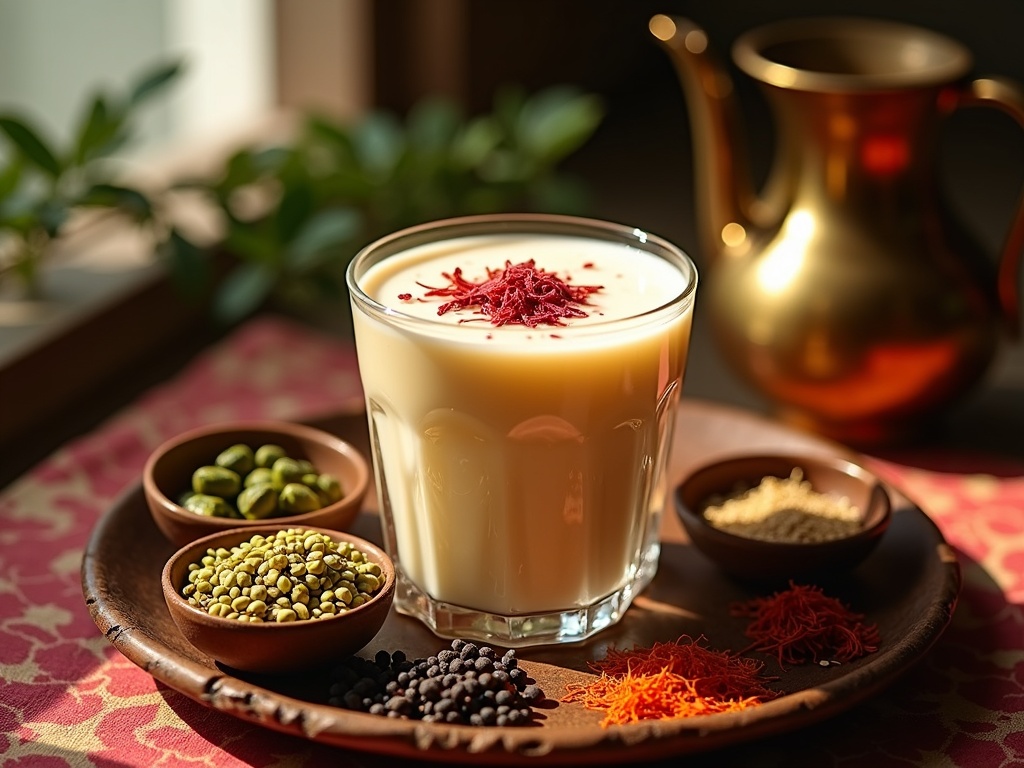
Preparing Your Traditional Thandai at Home
Making thandai at home is easier than you might think. I’ve perfected this traditional Indian drink over years of practice, and the key lies in preparation and patience.
Step-by-Step Thandai Preparation
First, I recommend soaking the nuts and seeds overnight. This important step softens almonds, cashews, pistachios, fennel seeds, and poppy seeds, making them easier to blend into a smooth paste.
- Place the ingredients in a bowl with enough water to cover.
- Let them sit for at least 8 hours.
After soaking:
- Drain the water and transfer the ingredients to a grinder.
- Add cardamom, peppercorns, and dried rose petals if available.
- Grind into a fine, smooth paste, adding a little water if needed to help the process.
Next comes the milk preparation. Heat full-fat milk in a heavy-bottomed pan until it comes to a gentle boil. This creates a rich base for your sweet Indian beverage that complements the nutty paste perfectly.
Once the milk is ready:
- Strain it through a fine sieve into another container.
- This removes any skin that formed and ensures a smooth consistency.
Now for the magical moment – mixing the paste with warm milk.
- Add the nut paste to the warm milk gradually.
- Stir continuously to avoid lumps.
- Ensure the paste completely dissolves into the milk.
For that authentic touch, add:
- A few strands of saffron
- A teaspoon of rose water
These ingredients give thandai its distinctive aroma and flavor that pairs wonderfully with crispy samosas during celebrations.
The final step is crucial – chill thoroughly before serving. Transfer the mixture to the refrigerator for at least 4 hours, though overnight is best. This allows all the flavors to meld together beautifully.
When serving, garnish with:
- Chopped nuts
- A few saffron strands
- A sprinkle of cardamom powder
For festive occasions, serve in traditional clay cups for an authentic experience. Thandai makes a refreshing counterpoint to spicy dishes like chicken biryani, creating a balanced meal.
Special Add-ins to Enhance Your Drink
Thandai, a traditional Indian beverage, is delightful on its own, but with a few special add-ins, I can transform it into a luxurious treat that impresses guests and satisfies my cravings. These enhancements not only boost the flavor profile but also add textural contrast and visual appeal that makes each sip more satisfying.
Elevated Garnishes and Mix-ins
Crushed rose petals are perhaps my favorite addition to thandai. They bring a subtle floral note that complements the spices perfectly while adding a gorgeous pink hue to the drink. I crush dried rose petals between my fingers and sprinkle them both into the mixture and on top as a garnish. The delicate aroma they release makes the drinking experience truly special, especially during festive celebrations.
Chopped nuts create a wonderful textural contrast when added to thandai. I prefer a mix of pistachios, almonds, and cashews chopped into small pieces. Some nuts can be blended into the drink itself, while saving the more attractive pieces for sprinkling on top. This adds a satisfying crunch and makes each glass look more inviting. I’ve found that lightly toasting the nuts before adding them enhances their flavor dramatically, bringing out their natural oils and aroma.
Dried melon seeds (char magaz) are an authentic addition that many people overlook. These small white seeds add a subtle nutty flavor and creamy texture when ground and mixed into the thandai. They’re also packed with nutrients, making them a functional add-in beyond just flavor. I like to soak them briefly before grinding them with the other ingredients for the smoothest texture.
For those who enjoy experimenting with traditional recipes, poppy seeds make an optional but interesting addition. They bring a unique nuttiness and slight thickening effect to the drink. I use them sparingly—just a teaspoon is enough to notice their effect without overpowering the other flavors in a batch of refreshing thandai that serves four people.
Edible silver foil (vark) transforms thandai into a truly royal beverage. This paper-thin edible silver makes any glass of thandai look festive and elegant. It’s particularly popular during Holi and weddings. I carefully place small pieces on top of the drink just before serving. The silver catches the light beautifully and signals to guests that they’re about to enjoy something special.
Beyond these traditional add-ins, I sometimes get creative with my thandai by incorporating:
- A twist of lemon or orange zest to add brightness
- A dash of saffron milk for luxury and color
- Coconut cream for added richness
- A sprinkle of cardamom powder on top for aromatic enhancement
- A cinnamon stick as both flavoring and stirrer
- Fresh mint leaves for a cooling effect
The beauty of thandai lies in its adaptability. While respecting its traditional roots, I can adjust and enhance it according to personal preference. The base of milk, nuts, and spices creates a canvas for creative additions that make each batch unique.
For a complete meal experience, I pair my enhanced thandai with crispy samosas or sweet treats like fresh chapatis with honey. The contrast between the cool, spiced drink and these complementary foods creates a balanced experience that heightens the enjoyment of each.
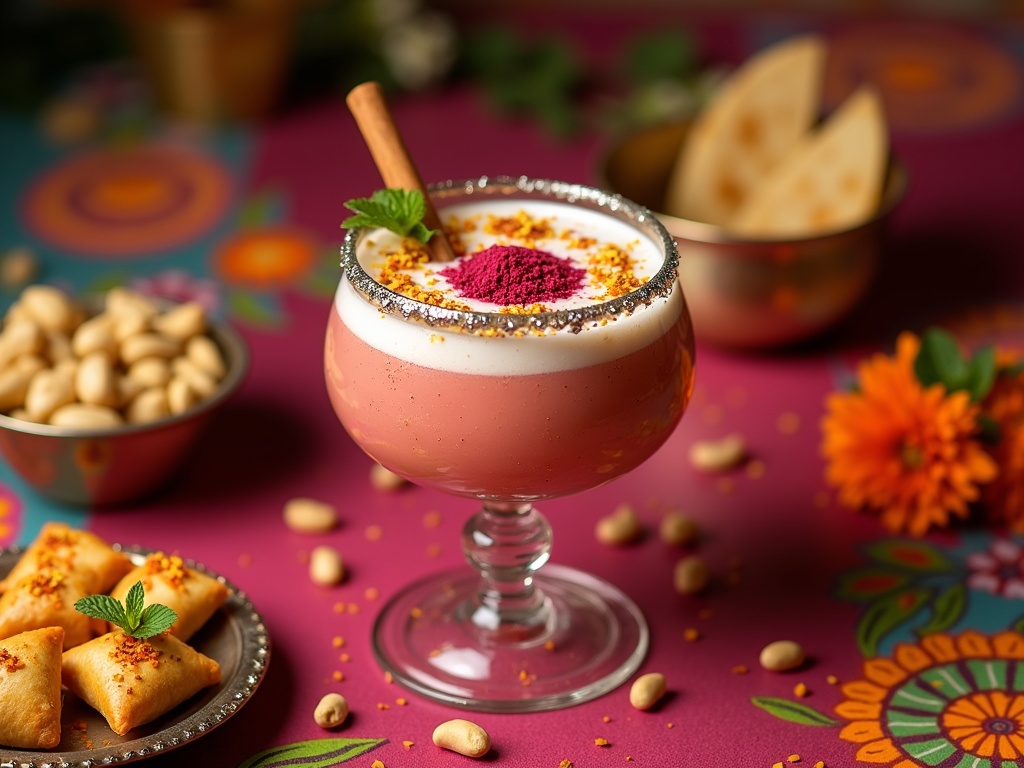
Cultural Significance and Serving Occasions
Thandai holds a special place in Indian culture as a traditional beverage deeply connected to celebrations and religious observances. This cooling drink, with its aromatic blend of spices, nuts, and milk, has transcended its role as a simple refreshment to become an integral part of many cultural events.
Festival Associations
Holi, the vibrant festival of colors, is perhaps the most iconic celebration associated with thandai. As participants throw colored powders and water at each other, thandai serves as the perfect accompaniment to cool down and refresh. The drink’s cooling properties make it ideal for this spring festival when temperatures start rising across India. Many families have their own secret thandai recipes that they prepare specifically for Holi gatherings, often passed down through generations.
Mahashivratri, the great night of Lord Shiva, marks another important occasion when thandai flows freely. During this night of spiritual awakening and meditation, devotees often consume thandai as a sacred offering. In some regions, a variation called bhang thandai (containing cannabis) is prepared, though the non-intoxicating version remains popular for family celebrations and those seeking the refreshing taste without the effects. The connection to Lord Shiva makes this drink particularly significant during this festival.
Beyond these two major celebrations, thandai appears at numerous other religious ceremonies throughout the year, especially those held during warmer months when its cooling properties are most appreciated. The drink’s status as both refreshment and offering makes it uniquely positioned in Indian cultural practices.
Social Celebrations and Gatherings
Wedding ceremonies in northern India often feature thandai as a welcome drink for guests. The rich, nutty flavor profile and luxurious texture make it an auspicious beverage that symbolizes prosperity and sweetness for the newlyweds. Serving thandai at weddings has seen a resurgence as couples embrace traditional elements in modern celebrations.
Special family gatherings benefit from the communal nature of thandai preparation and consumption. The process of making thandai—grinding the nuts and spices, straining the mixture, and sweetening to taste—often becomes a family activity that brings together different generations. These are the occasions when you might see gulab jamun and other sweets served alongside thandai, creating a complete traditional dessert experience.
The cultural significance of thandai extends to its role in hospitality traditions. Offering thandai to guests is considered a gesture of welcome and respect in many North Indian households. During summer gatherings, a glass of chilled thandai serves not just as refreshment but as a symbol of the host’s care for their visitors.
Many families have modernized their approach to serving thandai at social functions by:
- Creating thandai stations with different sweetness levels
- Offering both traditional and contemporary flavored variations
- Serving it alongside savory snacks like samosas
- Presenting it in elegant glassware for special occasions
- Preparing both alcoholic and non-alcoholic versions for diverse preferences
The prevalence of thandai at both religious and social gatherings demonstrates its versatility and cultural importance. Whether sipped during a quiet religious ceremony or enjoyed amid the chaos and joy of Holi, thandai connects celebrants to centuries of tradition while providing practical refreshment. Its enduring presence in Indian celebrations speaks to the drink’s perfect balance of spiritual significance, cultural relevance, and simple enjoyment.
Storage and Make-Ahead Tips
Thandai, with its aromatic blend of nuts, spices, and milk, can be prepared in advance to save time during festivities. I’ve found that making the paste ahead and storing it properly ensures you always have this refreshing drink ready to serve. The beauty of thandai lies in its versatility—both the paste and prepared drink can be stored effectively with the right approach.
Extending Shelf Life with Proper Storage
The thandai paste, which forms the flavor base for this traditional Indian beverage, can be refrigerated for up to 2 weeks when kept in an airtight container. This makes it incredibly convenient to prepare a batch during your weekend and enjoy it throughout the following days. To maintain freshness, I recommend storing the paste in a clean glass jar with a tight-fitting lid to prevent any absorption of refrigerator odors.
For the complete prepared drink with milk added, the shelf life shortens to 2–3 days in the refrigerator. The richness of milk makes it more perishable, so I always make sure to check for any signs of spoilage before serving leftovers. If you’re planning to serve crispy samosas as appetizers alongside thandai during a gathering, preparing both the samosa filling and thandai paste in advance can be a real time-saver.
Temperature plays a crucial role in maintaining the quality of stored thandai. The ideal refrigerator temperature should be below 40°F (4°C) to inhibit bacterial growth. I’ve noticed that storing the drink on the middle shelf rather than the door ensures more consistent cooling.
For longer preservation, freezing the thandai paste works exceptionally well. Here’s how I recommend doing it:
- Pour the blended paste into ice cube trays for convenient portion control
- Freeze until solid, then transfer the cubes to freezer bags
- Label with the date to track freshness (can be kept frozen for up to 3 months)
- Thaw only the number of cubes needed for each serving
This method is particularly useful when you want to enjoy thandai occasionally without making a fresh batch each time. Simply drop a cube or two into milk, allow it to thaw, and stir for a quick refreshment. After enjoying thandai, you might want to try making sweet gulab jamun using similar storage techniques for the sugar syrup.
Container selection significantly impacts how well thandai keeps. Glass containers are ideal as they don’t retain odors or stains from the turmeric and other spices in the mixture. If using plastic, opt for food-grade containers that are stain-resistant. Wide-mouth containers make it easier to scoop out the paste without contaminating the remainder.
When planning a menu that includes tangy pani puri and thandai, I prepare the thandai paste up to a week in advance, allowing me to focus on assembling the pani puri closer to serving time. This strategic make-ahead approach keeps entertaining stress-free while ensuring each item tastes fresh.
Before serving stored thandai, always give it a good stir as separation naturally occurs. If the drink has thickened in the refrigerator, a small addition of cold milk helps restore its ideal consistency. The flavors actually tend to develop and meld together beautifully after a day of resting, often resulting in a more harmonious taste profile.
Common Mistakes to Avoid
Making thandai at home can be straightforward, but there are a few pitfalls that might affect the final taste and texture. I often see these common errors when preparing this delicious festive drink, and avoiding them can truly elevate your traditional Indian beverage experience.
Ingredient Preparation Errors
Using cold milk to mix is a frequent mistake that can cause the thandai paste to clump instead of blending smoothly. Cold milk doesn’t allow the flavors to meld properly. Always use room temperature or slightly warm milk for the best results.
Insufficient soaking time for nuts and seeds is another critical error. These ingredients need adequate time to soften:
- Almonds should soak for at least 4-6 hours, preferably overnight
- Seeds like poppy and fennel require minimum 2-3 hours of soaking
- Dried rose petals need about 30 minutes to release their flavor
Over-grinding ingredients can release bitter oils, especially from nuts. Pulse the mixture instead of continuous grinding to maintain a balanced flavor profile, similar to how you’d carefully handle spices in a flavorful biryani.
Proportional Mistakes
The wrong milk-to-paste ratio can throw off the entire drink. Too much paste makes it overly thick and concentrated, while too little results in a watery, flavorless drink. I recommend starting with a 4:1 ratio of milk to paste and adjusting to taste.
Excessive sugar addition is tempting but masks the subtle flavors of spices and nuts. Start with less sugar than you think you need, as you can always add more. The natural sweetness from nuts and dried fruits like dates (if added) contributes significantly to the overall sweetness.
Many first-time thandai makers don’t strain the mixture properly, leaving a gritty texture. For a smooth drink reminiscent of the creamy consistency found in dessert preparations, double-strain through a fine mesh.
Not balancing the spices correctly can result in one flavor overpowering others. Cardamom, saffron, and pepper should complement rather than compete with each other. Tasting as you go helps you achieve that perfect harmony of flavors that makes thandai so special during festivals like Holi and Mahashivratri.
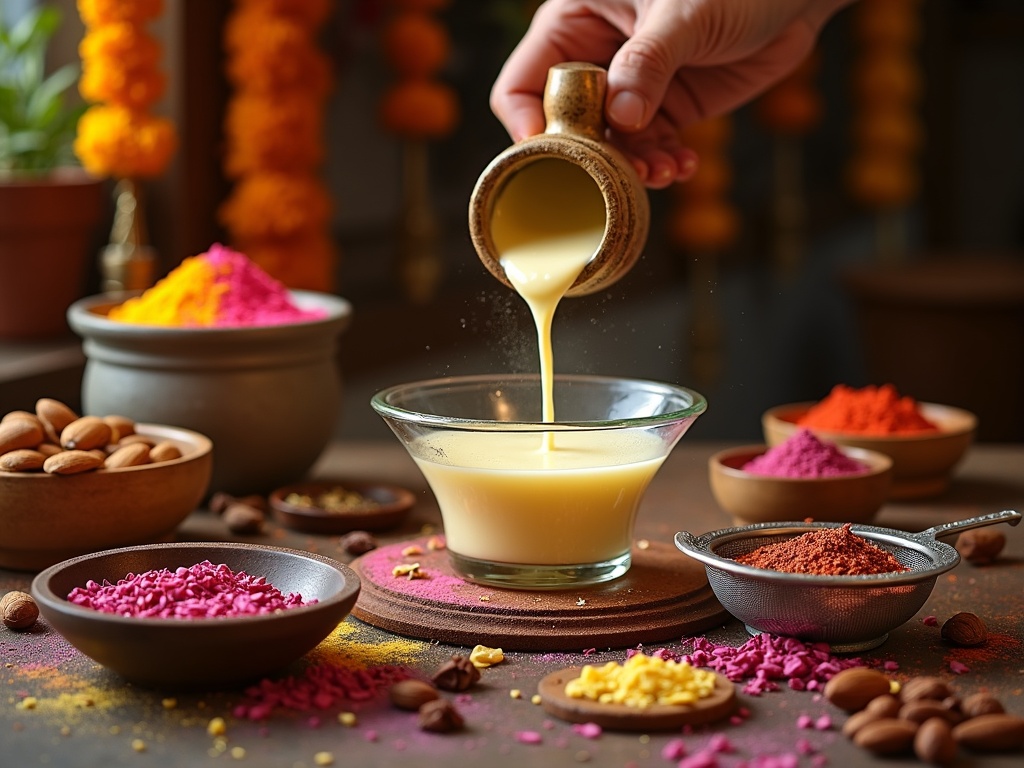
Health Benefits Worth Noting
Thandai offers more than just a refreshing taste experience; it packs a punch with health benefits that have been recognized in Ayurvedic traditions for centuries. This cooling drink combines numerous ingredients that work together to support overall wellbeing, making it both delicious and functional.
Cooling and Digestive Powerhouse
The natural cooling properties of thandai make it perfect for hot summer days. The combination of fennel seeds, rose petals, and cardamom creates a cooling effect on the body that helps regulate internal temperature. I’ve found this especially helpful during intense heat waves or after spending time outdoors.
Digestive benefits are another significant advantage of this traditional drink. The spice blend in thandai supports:
- Improved digestion through the presence of fennel seeds that reduce bloating
- Enhanced nutrient absorption thanks to black pepper
- Reduced indigestion due to cardamom’s carminative properties
- Soothed stomach discomfort from the cooling effect of rose petals
The energy-boosting ingredients in thandai provide sustainable vitality without the crash associated with caffeinated beverages. Nuts like almonds and pistachios deliver healthy fats and protein that maintain steady blood sugar levels. I often prepare pani puri as an appetizer followed by thandai for a balanced energy boost during gatherings.
Traditional medicinal value can’t be overlooked when discussing thandai. The drink contains saffron, which has been used for centuries to improve mood and reduce stress. Black pepper increases the bioavailability of nutrients, while cardamom supports respiratory health. These medicinal properties explain why thandai has remained popular alongside other classic Indian preparations like traditional gulab jamun in cultural celebrations.
From a nutritional standpoint, thandai offers impressive advantages. Each serving provides:
- Calcium from milk and poppy seeds for bone health
- Antioxidants from saffron and rose petals that fight free radicals
- Healthy fats from nuts that support brain function
- Essential minerals from seeds that support metabolic processes
When made with full-fat milk and paired with freshly prepared chapati, thandai creates a nutritionally balanced meal option that satisfies both hunger and nutritional needs without processed ingredients.
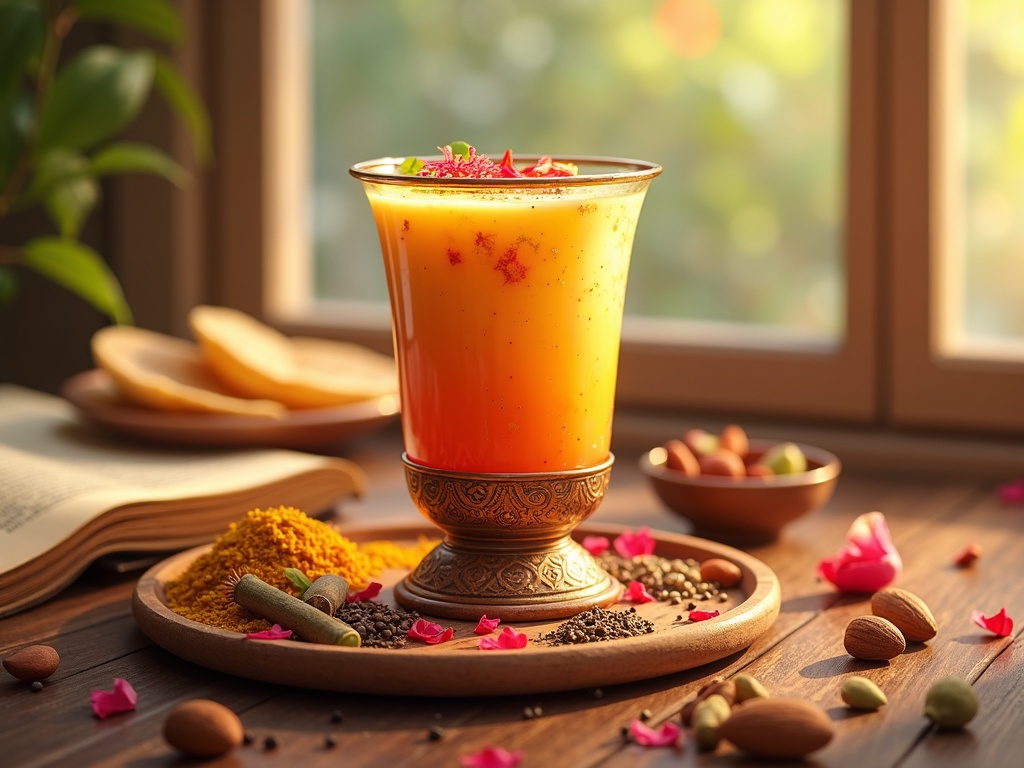
Serving Suggestions for Best Experience
Thandai, the traditional Indian spiced milk beverage, deserves to be served with attention to detail for maximum enjoyment. I’ve found that presentation and serving techniques can elevate this already delightful drink to new heights, impressing guests at festivals like Holi or Mahashivratri.
Creating the Perfect Thandai Experience
The ideal temperature for serving thandai is thoroughly chilled, typically between 35-40°F (2-4°C). For the best experience, I recommend refrigerating the prepared thandai for at least 3-4 hours before serving. On particularly hot days, adding ice cubes is perfectly acceptable, though this might slightly dilute the flavors. For a more sophisticated approach, freeze some thandai in an ice cube tray to use instead of regular ice cubes.
When it comes to garnishing, thandai offers endless creative possibilities. The traditional garnishes include:
- A light dusting of ground cardamom or nutmeg
- Slivered pistachios and almonds for texture and visual appeal
- Rose petals or dried rose petals for color contrast
- A few saffron strands for luxury and aroma
- Edible silver leaf (vark) for festive occasions
The right glass selection makes a significant difference in the thandai experience. Traditional clay cups (kulhads) keep the drink cool naturally and add an authentic touch. Crystal clear glasses work wonderfully too, especially tall ones that showcase the beautiful creamy color and garnishes. For formal gatherings, stemmed glassware elevates the presentation similar to how gulab jamun deserves a special serving dish for celebrations.
Portion sizing matters with thandai since it’s rich and filling. I typically serve 4-6 oz (120-180 ml) per person, which provides enough to savor without overwhelming the palate. Small portions also allow guests to enjoy other festival foods like crispy samosas or sweet treats alongside.
As for accompaniments, thandai pairs beautifully with:
- Sweet treats like malpua or jalebi
- Savory snacks such as mathri or namak pare
- Light cookies or biscuits for dipping
- Fresh seasonal fruits, particularly mangoes when in season
- Dry fruit assortments that complement the nuts already in thandai
For a complete festival meal, consider serving thandai after a main course of chicken biryani or other festive dishes. The cooling properties of thandai balance spicy food perfectly.
If you’re hosting a larger gathering, set up a thandai station with the base drink chilled in pitchers and various garnishes in small bowls, allowing guests to customize their drink. I’ve found that offering both regular and bhang thandai (where legal and appropriate) with clear labeling is important for adult celebrations.
For everyday enjoyment, simplify by serving thandai with a warm chapati and light vegetable curry for a balanced meal. The drink’s nutritional profile from nuts and milk makes it substantial enough to be part of a meal rather than just a beverage.
Remember that presentation affects perception—serving thandai in beautiful glasses with thoughtful garnishes transforms it from a simple drink into a memorable cultural experience, much like how pani puri becomes special with proper presentation despite its simple ingredients.
